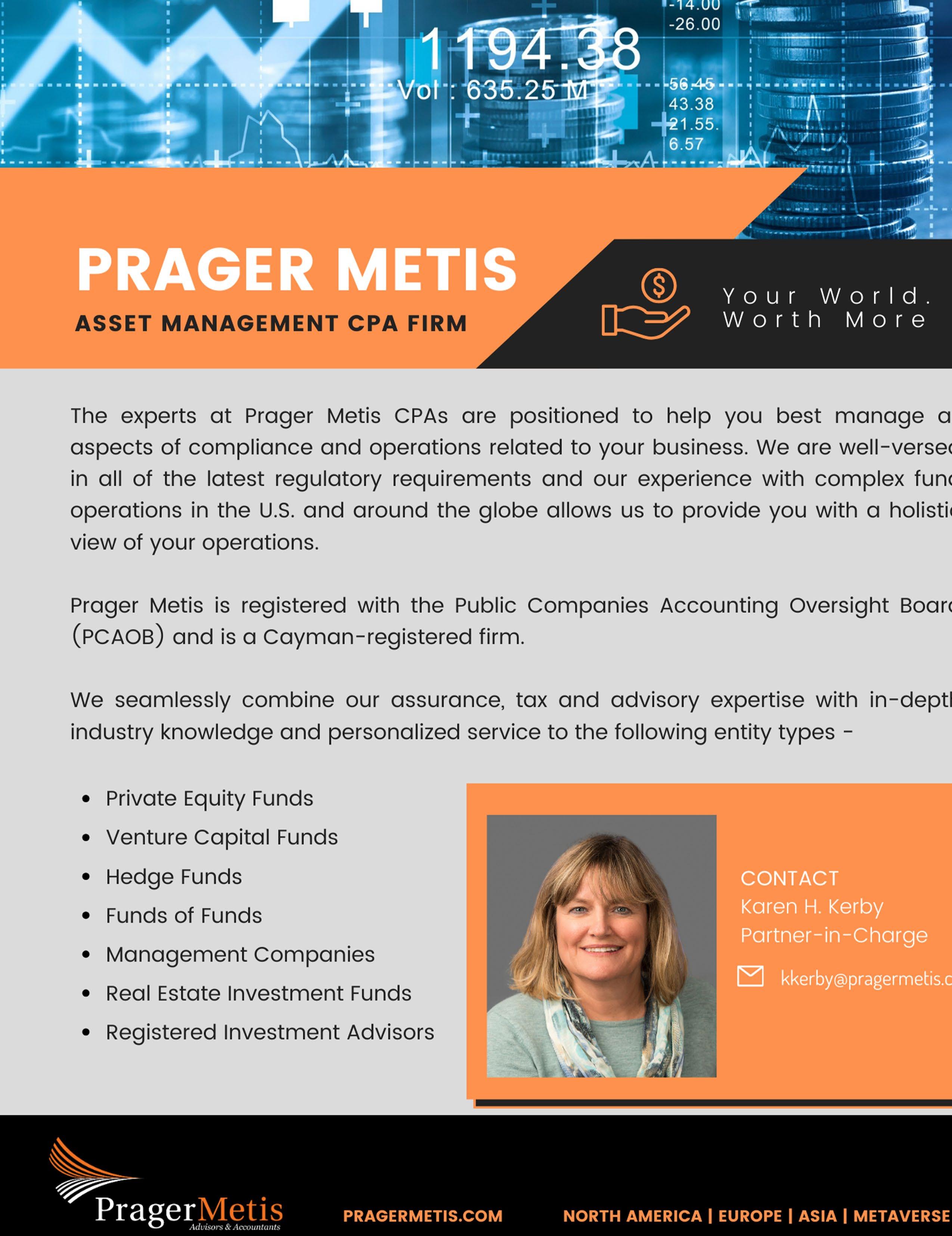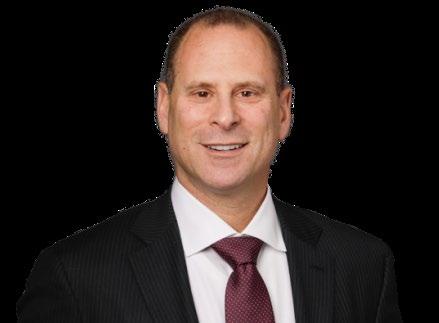

EDGE OF SEVENTEEN (ER, TWENTY FOUR):



The Fight for Dovishness

FEATURED BUSINESS LEADER

Richard Baum

UNVEILING THE WEALTH POTENTIAL

The Resilience of Wine Investments

“THAT’S NOT WHAT I INTENDED!”

Navigating the Complex Landscape of Letters of Intent

A DECADE LATER
Revisiting the Trados Case

INVESTING
Top 5 Minority Investor Mistakes

M&A BROKER EXEMPTION


THE ROAD TO EXIT
Essential Planning for Business Owners

Richard Baum, Managing Partner
Consumer Growth Partners



SPRING 2024




Our passion for service, deep business and financial services experience, and our sensible billing model, provide uncommon value without compromise. Experienced lawyers focused on: Sadis & Goldberg LLP | www.sadis.com Private Equity Real Estate Regulatory Compliance Securities Litigation Tax Corporate Family Office Fund Formation Litigation Mergers & Acquisitions
EDGE OF SEVENTEEN (ER, TWENTY-FOUR): THE FIGHT FOR DOVISHNESS
By Paul Marino
SADIS PARTNER SPOTLIGHT:
ABOUT SADIS
The firm maintains a diverse, businessoriented practice focused on investment funds, litigation, corporate, real estate, regulatory and compliance, tax and ERISA.
By Tommy Nordam Jensen
By Paul Marino
By Doug Hirsch & Sam Lieberman
Drawing on the experience and depth of our lawyers in these distinct areas, we can leverage each lawyer’s industryspecific knowledge to help our clients succeed. This collaborative approach brings to the table a collective insight that contributes to sensible, efficient resolutions, and allows us to remain attentive to the cost and time sensitivities that may be involved.
Sadis’s clients include domestic and international entities, financial institutions, hedge funds, private equity funds, venture capital funds, buyout funds, commodity pools, and numerous businesses operating in various industries around the world.

 Mitchell R.
Mitchell R.
38 24 20 16 12 10 9 6 THE EARNOUT PAGE 5 CONTRIBUTORS PAUL MARINO Head, Corporate and M&A Practice Groups Sadis & Goldberg Copyright 2024 The Earnout by Sadis & Goldberg, LLP. All rights reserved. Printed in the United States of America. CONTENTS
WELCOME
DAVID
TOP 5 MINORITY INVESTOR MISTAKES
FITZGERALD
THE WEALTH POTENTIAL: WINE CAPITAL FUND AND THE RESILIENCE OF WINE INVESTMENTS By
Cohen THE ROAD TO EXIT: ESSENTIAL PLANNING FOR BUSINESS OWNERS A DECADE LATER: REVISITING THE TRADOS CASE
FEATURED BUSINESS LEADER: RICHARD BAUM UNVEILING
By
Samantha
“THAT’S NOT WHAT I INTENDED!”: NAVIGATING THE COMPLEX LANDSCAPE OF LETTERS OF INTENT TOMMY NORDAM JENSEN CEO & Co-Founder Wine Capital Wine Fund JONATHAN BERNSTEIN Partner, Financial Services & Corporate Groups Sadis & Goldberg SAM LIEBERMAN Co-Head, Litigation Practice Group Sadis & Goldberg EDWARD MCNELIS Associate, Financial Services & Corporate Groups Sadis & Goldberg SAMANTHA ROMANO Associate, Financial Services Group Sadis & Goldberg DOUG HIRSCH Co-Head, Litigation Practice Group Sadis & Goldberg MITCHELL R. COHEN, ESQ. Partner US Capital Global 34 By Paul Marino & Jonathan Bernstein M&A BROKER EXEMPTION
Sam Lieberman, Paul Marino,
Romano and Edward McNelis
EDGE OF SEVENTEEN
(ER,TWENTY-FOUR)
The Fight for Dovishness: A
Dovish Fed
BY PAUL MARINO

Welcome to the inaugural issue of the Earnout, a print and digital publication focused squarely on the middle (upper, middle, and lower) financial services market (what is financial service: hedge, private equity, independent sponsors, venture and just about anyone who transacts in the largest segment of the US economy).
Looking back to early 2023, so many “strange” events occurred and rocked the market; I initially thought that the year was going to be dismal. For M&A, I was right; for the S&P and Dow, I was wrong. The broader
equity markets tested new highs, high yield outperformed (the constant specter of recession kept spreads wide but the strength of the economy kept small company balance sheets afloat—the perfect environment for junk to flourish) and American companies excelled beyond their peer groups on the global stage.
Notwithstanding the foregoing, certain sectors of the economy encountered setbacks, most notably mid-market and super regional banks such as SVB, First Republic, and Signature. These banks struggled to withstand the steep climb in interest rates and the decline in the market
value of T-bills they were obliged to hold due to banking regulation (even now regional banks are suffering due to regulatory burdens by either the fed or local governments (e.g., rent control—which is a post WWII law that should have, but never will, sunset)). Such challenges appear to be the norm in an environment marked by interventionist government policies.
Regardless of whether the administration is Republican or Democrat, the federal government and Federal Reserve consistently seek to manipulate and suppress the invisible hand guiding the broader marketplace. 1
Today, as we approach the midpoint of Q2, the broader market isn’t merely hoping, but rather expecting rate cuts (although the inflation print and job numbers suggest a rate cut won’t happen until early Q3). This sentiment is reflected in the pricing of indices like the S&P/Dow. Certain economists, particularly those adhering to Keynesian economics (including its evolved form, MMT), believe the Federal Reserve should have already initiated its easing program. We must consider that Fed Chairman, Jerome Powell, doesn’t want to replicate the trajectory of Arthur F. Burns, the Federal Reserve Chairman who hastily cut rates in the 1970s, only to witness a spike in inflation.
With that said, Powell might want to talk the market into easing interest rates on its
own (as some would argue should naturally occur) instead of lowering the terminal rate; but I doubt that will happen as interagency pressure to lower the terminal rate will steepen if/when the economy wobbles. The Federal Reserve does not want the economy to tank in an election year (especially considering the non-incumbent challenger hammered the federal reserve for four straight years).
CELEBRATE GOOD TIMES
In Q4 2023, the economy posted a growth rate in the 3% range, which was unexpected and underscores the resilience of the US consumer and the overall economy. However, consumer confidence slipped in November, albeit showing improvement from a low in October, and the Consumer Sentiment Index (CSI) started 2024 in negative territory (78.8, with the baseline set at 100). So, why is it that the economy is performing modestly while the average consumer, represented by John Q. Public, doesn’t feel positive? If you can answer that question, I am certain that the Biden Administration will hire you immediately.
Either way, most people outside of the coastal bubbles aren’t dressing up in disco outfits and celebrating any “Good Times” (apologies to Kool and the Gang), but instead are wearing plaid flannel and feeling rather grungy (ala Kurt Cobain).
THE EARNOUT PAGE 7 PAGE 6 THE EARNOUT
So, how does all this tie into the “real world”? It is quite simple: deals have stalled out because rising interest rates have increased the cost of leverage. Additionally, there is a lack of liquidity due to more middle-market banks pulling back from acquisition capital, and there is a concern about a “value trap” on behalf of buyers; and sellers, conversely, are fighting the last war on “value” – in other words, valuations seen in 2022 and 2021 should be the valuations in 2023 and 2024. As my grandmother would say, “dem days are over.”
GOOD TIMES BAD TIMES
That could be what the 2024 deal book looks like by the time this year is over. For the first few months of the year, the $2.6 trillion in private equity dry powder will push many deals over the goal line, much like a

PAUL MARINO Partner
Sadis & Goldberg pmarino@sadis.com
Paul Marino is a partner in the Financial Services and Corporate Groups. Paul focuses his practice in matters concerning financial services, corporate law and corporate finance. Paul provides counsel in the areas of private equity funds and mergers and acquisitions for private equity firms and public and private companies and private equity fund and hedge fund formation.
Jason Kelce tush push.
Together with dry powder, sellers and buyers will bridge the valuation chasm with earnouts, equity rollovers, and stock-for-stock swaps. According to SRS Acquiom, 2023 saw 32% of all deals using earnouts, almost doubling in six years. Earnouts, once scorned by buy-side/sell-side practitioners (excluding commercial litigators), are now commonplace in most transactions, especially when the seller remains in the management team. Furthermore, there will be more equity rollovers in 2024 than in the past, mostly to bridge the gap on valuation.
While cash and creative deal-making will make the first half of the year a winner for deals, persistent inflation and, in this humble attorney’s belief, a higher terminal rate (think only a 50 bps cut) will sap the energy from the “party”. Furthermore, middle-market banks will continue to pull back from deploying acquisition capital, and although that space will be filled by private credit, the cost of capital for buyers will increase, especially if the terminal rate doesn’t hit the street’s target. Finally (for more bad news), as we near the end of the year, the election will, regardless of who wins, likely make a close to majority uncertain, and there is nothing the market abhors more than uncertainty.
In sum, my advice for 2024 is to heed the wisdom of Winnipeg’s Finest, Bachman Turner Overdrive, and “Take Care of Business” until you can’t “Let it Ride” any longer.
1 As an aside, whether one wants to believe it or not, the GFC was a government caused (and partially solved) crisis—for example, the ideology that everyone should own a home lead to more relaxed lending requirements (see, no money down or no income verification documents) leading to Fannie and Freddie buying covenant light (or just light) paper on the open market.
SADIS PARTNER SPOTLIGHT
 DAVID FITZGERALD
DAVID FITZGERALD
Partner, Financial Services & Corporate Groups
PRACTICE AREAS
Investment Funds
Securities
Joint Ventures
Regulatory Compliance
Investment Advisers
EDUCATION
J.D., Fordham University School of Law, 1998
Associate Editor Fordham Law Review
B.A., Georgetown University, 1991
ADMISSIONS
New York
David Fitzgerald is a Partner in the firm’s Financial Services and Corporate Groups. David’s practice focuses on investment funds, securities, joint ventures, regulatory compliance and investment advisers. He regularly structures and organizes hedge funds, private equity funds, funds of funds, separately managed accounts and hybrid funds. Additionally, he advises private fund managers on structure, compensation, employment and investor issues, and other matters relating to management companies.
Drawing on his 16 years of experience as an institutional Chief Compliance Officer and General Counsel, David provides ongoing advice to investment advisers on securities law issues, including SEC filings. His practice also involves counseling clients in SEC regulatory matters, including compliance issues related to registered advisers.
David came to Sadis after over six years as the General Counsel and Chief Compliance Officer of Gabelli & Company Investment Advisers, Inc., the registered alternative asset manager affiliated with the Gabelli group. While at Gabelli, David was responsible for all legal, regulatory and compliance matters involving the adviser, including fund formation. During that time, he also advised the adviser’s public company parent on its SEC filing obligations and on a number of corporate finance matters, including the spinoff of its registered broker dealer to its shareholders and the launch of its SPAC platform.
David has over twenty-three years of experience in the legal and financial services industries. Prior to joining Gabelli, David was the Associate General Counsel of Sciens Capital, a registered investment adviser and the head of UBS’s leveraged finance legal team in Europe. David was also previously associated with the law firms of Shearman & Sterling LLP and Cahill Gordon & Reindel.
THE EARNOUT PAGE 9 PAGE 8 THE EARNOUT

RICHARD BAUM: A Journey from Consulting and Retail to The Grandfather of the Independent Sponsor Movement
Richard Baum’s path to private equity unfolds as a captivating narrative, punctuated by twists and turns that have shaped his remarkable journey to success. Starting at University of Michigan, and subsequently Harvard Law School, Baum’s initial legal aspirations gradually gave way to an abiding ardor for the corporate arena.
While attending law school, a friend introduced him to the Boston Consulting Group (BCG), where he would discover the world of corporate strategy and gain Fortune 500 exposure. Joining straight out of law school, Baum began a six-year journey working with some of the brightest minds in the industry and intersected with such notable figures as Mitt Romney and Benjamin Netanyahu. These encounters not only enriched Baum’s network but also provided him with invaluable insights into the inner workings of Fortune 500 behemoths.
Transitioning from consulting to the retail sector, Baum’s time at Bloomingdales emerged as a defining chapter. Despite facing initial skepticism, his unwavering determination and visionary acumen
propelled him to excel as a retail merchant, garnering admiration and forging lasting alliances within the industry. Yet, Baum’s journey in the sector was not without its share of trials, including setbacks in roles with vendors and ventures in children’s apparel. Nonetheless, these challenges served as crucibles, tempering Baum’s mettle and fortifying his resolve.
Today, as the managing partner of Consumer Growth Partners and a partner at Founder Solutions, Baum’s narrative stands as a testament to the transformative power of perseverance and resilience in the unpredictable terrain of Independent Sponsors (a term he coined a number of years ago). His story beckons aspiring entrepreneurs and seasoned professionals alike to embrace the path, armed with grit and determination.
For an in-depth exploration of Richard Baum’s remarkable journey and insights, watch the full interview.
THE EARNOUT PAGE 11 PAGE 10 THE EARNOUT FEATURED BUSINESS LEADER RICHARD BAUM
CLICK TO WATCH FULL INTERVIEW
UNVEILING THE WEALTH POTENTIAL: Wine Capital Fund and the Resilience of Wine Investments
 BY TOMMY NORDAM JENSEN CEO & Co-Founder Wine Capital Fund
BY TOMMY NORDAM JENSEN CEO & Co-Founder Wine Capital Fund
In an era marked by economic uncertainties and volatile financial markets, investors are increasingly seeking refuge in alternative assets that promise stability and growth. Among these alternatives, the fine wine market stands out as a beacon of opportunity, offering not only the potential for attractive returns but also the allure of tangible, finite assets with intrinsic value. At the forefront of this burgeoning market is Wine Capital Fund, a structured investment vehicle designed to unlock the wealth potential of wine investments. In this comprehensive exploration, we delve deep into the dynamics of wine investment, the unique advantages of Wine Capital Fund, and the data-driven insights that underpin its success.
THE EARNOUT PAGE 13 PAGE 12 THE EARNOUT

THE HISTORICAL RETURNS OF WINE INVESTMENTS
The stellar performance of fine wine over the past several decades has cemented its status as a formidable asset class. The Liv-ex Fine Wine 1000 Index illustrates that fine wine has consistently outpaced many global equity indices, offering investors both robust capital appreciation and a hedge against economic fluctuations. “The historical resilience and growth of fine wine investments are irrefutable, outshining traditional markets and standing strong amidst economic tides,” asserts Tommy N. Jensen, CEO and co-founder of Wine Capital Fund. This underpins the fund’s strategy, which aims to capitalize on the natural price support driven by the scarcity and global desirability of top-tier wines.
NAVIGATING THE COMPLEXITIES
“The historical resilience and growth of fine wine investments are irrefutable, outshining traditional markets and standing strong amidst economic tides.”
- Tommy N. Jensen
DIVERSIFICATION AND STABILITY
eventual strategic sale.
EMBRACING INNOVATION
Innovation lies at the heart of Wine Capital Fund’s approach to wine investment. Leveraging cutting-edge technologies and data analytics, the fund continuously monitors market dynamics, identifies emerging trends, and seizes investment opportunities with precision. As co-founder Håkon Harberg aptly puts it, “We begin with data. Our approach is rooted in empirical evidence, seeking patterns that are consistently reproducible.”
This data-driven philosophy underscores the fund’s commitment to delivering tangible results based on empirical evidence and market insights.
Investing in wine is not without its challenges, as the market is subject to a myriad of factors ranging from vintage quality to geopolitical events. Wine Capital Fund addresses these complexities by providing investors with access to a diversified portfolio of fine wines, carefully curated by a team of industry experts. Through rigorous due diligence and meticulous selection criteria, the fund mitigates risks and maximizes returns, offering investors a strategic pathway to wealth accumulation.
One of the key advantages of wine investment, particularly through a structured fund like Wine Capital, is diversification. Fine wine exhibits low correlation with traditional financial assets, making it an attractive addition to a well-balanced portfolio. Moreover, the stable returns offered by the wine market, coupled with the potential for capital appreciation, serve as a hedge against market volatility and inflationary pressures, enhancing portfolio resilience and long-term wealth preservation.
STRUCTURE AND FINANCIAL INSTRUMENT
The fund’s PE structure is adept at navigating the wine market’s nuances, allowing for strategic acquisitions, optimal holding periods, and planned exits to realize maximum returns. “Wine Capital Fund seeks to transform wine into a financial instrument, offering investors the opportunity to diversify their portfolios with a proven asset class,” Jensen elaborates. This approach aligns the fund with the most successful practices in wealth management, targeting undervalued assets with growth potential and ensuring their professional management and
CONCLUSION
Wine Capital Fund represents a compelling opportunity for investors seeking exposure to the resilient and lucrative world of wine investments. By combining expertise, innovation, and a data-driven approach, the fund offers a strategic pathway to wealth accumulation and portfolio diversification. As the fine wine market continues to evolve, Wine Capital Fund stands poised to deliver sustainable returns and enduring value, reaffirming its position as a trusted partner in wealth management and investment excellence.
TOMMY NORDAM JENSEN
CEO & Co-Founder Wine Capital Fund
tommy@winecapital.fund winecapital.fund

THE EARNOUT PAGE 15 PAGE 14 THE EARNOUT

“That’s NOT What I Intended!”
NAVIGATING THE COMPLEX LANDSCAPE OF LETTERS OF INTENT
“It would be difficult to find a less predictable area of contract law.”
- E. Allan Farnsworth
BY SAM LIEBERMAN, PAUL MARINO
ROMANO AND EDWARD MCNELIS
In the realm of contract law, few documents are as often used, overlooked, and misunderstood as letters of intent (“LOIs”). Despite their varying formats and terms, LOIs primarily serve to outline the basic structure of a deal and express the parties’ intent to continue negotiations.
But despite the ubiquity of LOIs, there is often disagreement between the parties about their legal status, prompting caution among lawyers. The well-known case of Texaco, Inc. v. Pennzoil, Co., exemplifies the high stakes involved, as an LOI was deemed a binding contract, resulting in a staggering $8.5 billion damages award against Texaco. (729 S.W.2d 768 [Tex. App. 1987]).
z This article delves into the complexities of LOIs and how they are interpreted by courts, with a specific focus on the perspectives of New York and Delaware.
z Understanding the nuances and potential liabilities of LOIs is crucial, and seeking guidance from legal experts well-versed in contract law is necessary to protect an LOI party’s interests.
THE EARNOUT PAGE 17 PAGE 16 THE EARNOUT
SAMANTHA
UNDERSTANDING LOIs
LOIs are typically considered “Type II preliminary agreements,” which are binding to the extent they reflect agreement on specific major terms (while leaving room for further negotiation on other terms). This flexibility is advantageous when the parties want to solidify their agreement on specific major terms without committing to all issues upfront, and provides an opportunity to refine the remaining provisions during the negotiation process. In contrast, “Type I Agreements” cover all issues and are fully binding (IDT Corp. v. Tyco Grp., S.A.R.L., 54 A.D.3d 273, 275[1st Dept. 2008]).
DISCLAIMERS ARE INSUFFICIENT TO AVOID A BINDING CONTRACT
Disclaimers stating that an LOI is “nonbinding,” or not a contract are usually insufficient to prevent a court from holding that an LOI is binding. To properly discuss disclaimers, it is necessary to discuss the duty to negotiate in good faith. When it comes to performing the contract, every party of every contract has an implied duty of good faith and fair dealing to cooperate with the contract.

CHOICE OF LAW: NEW YORK AND DELAWARE DIFFER ON EXPECTATION DAMAGES
Statements within an LOI stating that its terms are non-binding or not a contract are not sufficient alone to disclaim the formation of a Type II preliminary agreement or the duty to negotiate in good faith (Cambridge Cap. LLC v. Ruby Has LLC, 565 F. Supp. 3d 420, 445 [S.D.N.Y. 2021]). Even an extensive disclaimer stating that no obligations or agreements exist may not be enough to negate the binding nature of an LOI, especially if an exclusivity provision is included.
Breach of exclusivity provisions often leads to liability in LOI cases. Parties may find themselves legally accountable if they violate exclusivity clauses outlined in the LOI.
It is crucial to note that Delaware and New York have differing perspectives on the recoverable damages in LOI cases. This makes it important for parties to carefully consider Choice of Law.
In Delaware, expectation damages can be awarded based on what would have occurred if the deal had gone forward – which can significantly increase a damages claim. This includes damages based on lost profits of the business that would have resulted from the agreement that can be shown with reasonable certainty, even if these estimates are somewhat speculative (SIGA Techs., Inc. v. PharmAthene, Inc., 67 A.3d 330, 350–51 [Del. 2013]; SIGA Techs., Inc. v. PharmAthene, Inc., 132 A.3d 1108, 1128-29 [Del. 2015]). Delaware Courts allow more leeway to prove expectation damages
based on an equitable principle that a “breaching party cannot avoid responsibility” by arguing that “expectation damages are speculative because they come from an uncertain world created by the wrongdoer.”
On the other hand, New York generally limits damages to reliance damages. These damages include costs incurred during due diligence, out-ofpocket expenses on lawyers or advisers, and under specific circumstances, the cost of cover to pursue an alternative deal instead of the one outlined in the LOI (Cresco Labs N.Y., LLC v. Fiorello Pharms., Inc., 178 N.Y.S.3d 425 [N.Y. Sup. Ct. 2022]).
Furthermore, New York allows recovery based on specific “liquidated damages” stated in the LOI, such as “no-shop” or break-up fees (Cresco Labs N.Y., LLC v. Fiorello Pharms., Inc., 178 N.Y.S.3d 425 [N.Y. Sup. Ct.
2022]; FCS Advisors, Inc. v. Fair Fin. Co., 378 F. App’x 65, 67–68 [2d Cir. 2010]).
IMPLICATIONS & RECOMMENDATIONS
Understanding the legal implications of LOIs is essential for both parties involved in a deal. Proper drafting, including clear disclaimers or exclusivity provisions, can help avoid disputes, unnecessary costs, and potential liabilities. Before drafting and/or agreeing to the terms of an LOI or similar preliminary agreement, parties should consult with lawyers who focus on LOI contract law to ensure that an LOI accurately reflects the intentions of the parties about which terms should be binding and what damages are recoverable. If you have any questions about a Letter of Intent or other preliminary agreement, please contact Partners Sam Lieberman (slieberman@sadis. com) or Paul Marino (pmarino@sadis.com)
THE EARNOUT PAGE 19 PAGE 18 THE EARNOUT
A DECADE LATER: REVISITING THE TRADOS CASE
WHENVENTURECAPITALINTERESTSCLASHWITHDIRECTOR FIDUCIARYDUTIES
BY PAUL MARINO
In the ever-evolving world of corporate law, certain cases leave an indelible mark on legal discourse. Trados, a Delaware Chancery Court case that unfolded a decade ago, is one such landmark. It involved a clash between venture capital funds and common shareholders, shedding light on the fiduciary duties of directors and the delicate balance between preferred and common stock interests. A decade later, we revisit Trados to examine its repercussions and enduring influence.
BACKGROUND
Trados, a privately-held software company, found itself in the precarious position of holding a venture-backed “living dead” investment, where it was neither a clear winner nor a complete loss. The venture capital backers holding preferred stock decided to exit the investment and focus their resources elsewhere. While exiting, they implemented a “management incentive plan” to motivate the new management team towards a sale, offering them up to 15% of the sale price. Eventually, the company was sold, but after paying management approximately $8 million, the remaining $52 million fell short of satisfying the preferred stockholders’ liquidation preference, leaving common stockholders with nothing.
In a legal battle following the Trados sale, common stockholders sued, contending that they received no
Trados provided common shareholders with increased leverage to challenge sales transactions involving VC-backed companies, prompting VC funds to exercise greater caution in their exit strategies.
This case serves as a reminder for private company directors to consider factors such as establishing a special committee and upholding the Revlon Standard when navigating transactions.
compensation while the preferred stockholders benefited. The court emphasized that directors owe their fiduciary duties to common stockholders, not the preferred ones, whose rights are based on contracts. The directors involved in the sale had conflicts of interest as they were connected to the preferred stockholders or stood to gain from the management incentive plan. Consequently, the court applied a rigorous fairness test. The court determined that the process was unfair to common stockholders, as it was driven by the preferred stockholders’ desire to exit without considering
common stockholders’ interests. However, the court deemed the sale price of $60 million fair, relying on the directors’ valuation expert and discrediting the plaintiff’s expert.
SERVING TWO MASTERS: CONFLICTS IN VC-BACKED FIRM GOVERNANCE
Trados injected itself into the realm of Delaware jurisprudence by addressing a fundamental question: to whom do directors owe their fiduciary duties when faced with conflicts between common and preferred shareholders? Is it the corporation, the common holders, or the preferred holders who negotiate for board control? The court’s ruling established a precedent that tilted the scales towards common-maximization. In essence, the court stated that boards, when exercising discretionary judgment, should prioritize the interests of common stockholders over the special rights and preferences
enjoyed by preferred stock.
THE RIPPLE EFFECT
A recent study conducted by Goethe University in Frankfurt delves into the profound impact of Trados on the exit decisions of venture capital funds, shedding light on the significant influence that legal rulings exert on market dynamics. Utilizing a rigorous difference-in-differences estimation method, the study meticulously analyzes the likelihood of salesbased exits for VCs nearing maturity compared to those further away, both before and after the Trados ruling.
The findings strikingly affirm that Trados has significantly bolstered the leverage of common shareholders, granting them the power to challenge sales transactions involving VC-backed companies. Following Trados, VC funds exhibit a heightened

THE EARNOUT PAGE 21 PAGE 20 THE EARNOUT
level of caution in their exit strategies, particularly when confronted with liquidity pressures. Trados has introduced a fresh dynamic that compels maturing VC funds to exercise greater prudence, steering them away from undervalued and detrimental sales that would disproportionately harm common shareholders.
TAKEAWAYS
In the final analysis, the Delaware Court of Chancery ruled that while the sale process of Trados lacked fairness, the price itself was deemed fair as the shares held no economic value. It can be described as a “no harm, no foul” outcome in common terms. Nonetheless, revisiting this case serves as a valuable reminder for private company directors to consider several important factors when navigating transactions.
For one, the establishment of a special committee composed of independent directors during the sale process is worth considering. This proactive step helps address conflicts of interest and ensures a transparent and impartial decision-making process. By adopting a worst-case perspective and appointing directors with no affiliations to venture funds, companies can minimize the potential for legal challenges and achieve better outcomes for common stockholders.
Moreover, upholding the Revlon Standard remains of paramount importance when embarking on a sale. Adhering to one’s Revlon Standard duties not only mitigates the risk of post-sale litigation but also establishes a more favorable standard of review.
In navigating the intricate landscape of VC exits and dispositions in general, it is advisable to seek professional legal counsel to ensure a comprehensive understanding of fiduciary duties and best practices. For further inquiries, please contact Paul Marino (pmarino@ sadis.com).





INDEPENDENT SPONSOR AND CAPITAL PROVIDER SYMPOSIUM
WEDNESDAY
8 a.m. - 6 p.m.
RSM US LLP
We are pleased to be hosting another symposium focused on bringing together qualified independent sponsors and capital providers.
NEW YORK, NY MAY 15, 2024
151 W. 42ND ST
This exclusive 1 day event focuses on high level networking opportunities between capital providers and Independent Sponsors To participate, capital providers must have completed a minimum of 2 Independent Sponsor deals within the last two years, and Independent Sponsors must have done a minimum of 1 deal in the last three years with a minimum of $3mm of EBITDA or higher. To register, please contact Lauren Scott at lscott@sadis.com.
PAGE 22 THE EARNOUT
TOP 5 MINORITY INVESTOR MISTAKES
BY DOUG HIRSCH & SAM LIEBERMAN

At Sadis, we have noticed that many investors with a minority position in a partnership, LLC or corporation, come to us with an issue and are surprised when we advise them of the broad range of minority investor rights and remedies available to address their situation. Often, we are able to monetize what they thought was an illiquid interest. Here are the top 5 mistakes we see minority investors make.
THE EARNOUT PAGE 25 PAGE 24 THE EARNOUT
MISTAKE NUMBER ONE
“I OWN A VERY SMALL INTEREST IN THE ENTITY SO I REALLY HAVE NO RIGHTS”
This is incorrect. Minority investors have many rights provided by statute and common law, some of which cannot be waived.

THE EARNOUT PAGE 27 PAGE 26 THE EARNOUT
MISTAKE NUMBER
TWO
“I SIGNED AN LLC OPERATING AGREEMENT WITH A PROVISION STATING I WAIVED MY RIGHT TO SEEK A DISSOLUTION, SO THEREFORE, I CANNOT SEEK DISSOLUTION”

MISTAKE
NUMBER THREE
“I DON’T HAVE A FORMAL SIGNED AGREEMENT DOCUMENTING MY INTEREST IN THE COMPANY, SO I HAVE NO RIGHTS”
Not all waivers are enforceable. States that adopted the model Uniform LLC Act often have LLC Acts that prohibit the waiver of the right to dissolution. We recently handled such a case and obtained a ruling that the dissolution waiver was unenforceable. This was a primary factor in allowing us to secure a $14.5 million buyout of our client’s minority membership interest.

This is not necessarily true. Oftentimes, emails or other conduct are a sufficient writing to form an enforceable contract. In certain situations, even an oral agreement regarding ownership in a partnership or company can be enforceable.
THE EARNOUT PAGE 29 PAGE 28 THE EARNOUT
MISTAKE NUMBER FOUR

“THE DEAL WILL BE APPROVED NO MATTER HOW I VOTE – SO THERE’S NOTHING I CAN DO”
Wrong. Minority Investors have appraisal rights to opt out of a bad merger, acquisition or similar deal and to instead get paid the fair value of their investment plus interest, as decided by a court. Minority investors can also sue to recover damages for deals involving conflicts of interest or a grossly unfair deal price. We have won appraisal rights actions awarding investors a premium of 12%-200% over the deal price, with total recoveries over $60 million.
THE EARNOUT PAGE 31 PAGE 30 THE EARNOUT
MISTAKE NUMBER FIVE
“THE LARGEST INVESTOR HAS ALL THE POWER, SO I HAVE TO DO WHAT HE SAYS OR ELSE”

Not true. The law protects minority investors against coercion, selfdealing, oppression, waste, and other misconduct by majority investors, officers, and directors. Courts can award you significant damages, or invalidate majority investor actions that involve wrongdoing. We have won many cases for minority investors who thought they had no real options before they spoke to us. With the right lawyer and the fee arrangement, you can stand up to the bully.

Over the last three years, we have recovered more than $120 Million for our clients in New York, Delaware and Florida. We specialize in handling shareholder, partnership, and LLC disputes and often handle the cases on a full contingency basis. We’d welcome an opportunity to speak with you and the initial consultation is at no cost to you. If you have an investment or business dispute and would like our help resolving it, please reach out to Doug Hirsch or Sam Lieberman.
 DOUG HIRSCH Partner, Sadis & Goldberg dhirsch@sadis.com
DOUG HIRSCH Partner, Sadis & Goldberg dhirsch@sadis.com
Independent Sponsor Capital
For 28 years, Frisch Capital Partners has specialized in raising equity and debt for value-added Independent Sponsor transactions.
DOUG HIRSCH Partner, Sadis & Goldberg dhirsch@sadis.com

SAM
LIEBERMAN Partner, Sadis & Goldberg slieberman@sadis.com

Securities offered through GT Securities, Inc., member FINRA, SIPC. frischcapital.com
EBITDA $3 Million
| 706-227-4144 Over $1.5 Billion of Capital Raised
-$40 Million
M&A Broker Exemption
BY PAUL MARINO AND JONATHAN BERNSTEIN

SEC No-Action Letter, and also, notably, establishes new limitations on the size of private companies in eligible transactions, based on revenue and earnings before interest, taxes, depreciation, and amortization (“EBITDA”) figures. The Proposed Model Rule will align with the Federal Exemption and may provide states with a blueprint for their own state-level M&A Broker exemption, which is absent from the Federal

M&A Brokers should familiarize themselves with the Federal Exemption’s approach to a buyer’s involvement in the control of the target company. Previously, M&A Brokers were exempted only if the transaction resulted in the buyer controlling and actively operating the business. Under the Federal Exemption, M&A Brokers will only need to have a reasonable belief that the buyer will control and
THE EARNOUT PAGE 35 PAGE 34 THE EARNOUT
THE SEC’S NO-ACTION LETTER
The No-Action Letter exempted M&A Brokers from broker-dealer registration under the Securities Exchange Act of 1934 (the “Exchange Act”). M&A Brokers are those involved in privately-held company transactions where the buyer “will actively operate the company or the business conducted with the assets of the company.” In drawing from the NoAction Letter, the Federal Exemption copied many of the same qualifiers. Under both the No-Action Letter and (now) Federal Exemption, M&A Brokers seeking an exemption from federal broker-dealer registration cannot:
i. bind parties to an M&A transaction;
ii. directly, or indirectly, provide financing (unless assisting party with unaffiliated third-party financing and disclosing assistance in writing);
iii. (maintain custody of the buyer’s or seller’s funds or securities;
iv. engage in an M&A transaction involving a public offering or public shell company;
v. represent both buyer and seller without disclosure and written consent
vi. facilitate an M&A transaction with a group of buyers formed with the assistance of the M&A Broker; and/or
vii. facilitate a transaction involving passive buyers or buyers who do not control and actively operate the business.
Also, an M&A Broker that has been (x) barred by the SEC, any state, or any self-regulatory organization, and/or (y) suspended from associating with a brokerdealer cannot rely on the Federal Exemption.
KEY DIFFERENCES IN THE FEDERAL EXEMPTION
Under the No-Action Letter, a “Privately-Held Company” was defined as a company that (i) has not
registered and is not required to be registered under Section 12 of the Exchange Act, (ii) is required to file under Section 15(d) of the Exchange Act, and (iii) is not considered a “shell” company. Under the Federal Exemption, Congress kept the registration and filing requirements in items (i), (ii), and (iii), but has also added limitations to the size of the company involved, defining an “Eligible Privately Held Company” as one with:
• an EBITDA of less than $25 million in their last complete fiscal year; and/or
• gross revenues of less than $250 million in their last complete fiscal year.
Under the No-Action Letter, M&A Brokers who engaged in transactions with Privately-Held Companies above these limits were exempted from broker-dealer registration with the SEC, assuming they still complied with all other requirements. However, the EBITDA and gross revenue limits for an Eligible Privately Held Company under the Federal Exemption will likely significantly restrict the number of opportunities for M&A Brokers. As private company trends show increased gross revenues and EBITDA figures for small entities, the number of eligible companies is likely to shrink, thereby limiting growth opportunities and investor exit options for private companies that previously relied on M&A Brokers.
Finally, the Federal Exemption aligns with the NoAction Letter in the lack of preemption of state broker-dealer registration requirements. Under both the No-Action Letter and the Federal Exemption, an M&A Broker exempt from federal broker-dealer registration under the Federal Exemption is not exempt from any applicable state broker-dealer registration laws, including state “blue sky” laws.
LOOKING FORWARD
The Proposed Model Rule updates the NASAA’s initial model rule for M&A Brokers released in 2015 (the “2015 Model Rule”) in order to match the language of the Federal Exemption. The 2015 Model Rule was intended to establish a framework for U.S. Congress (“Congress”) or the states seeking to enact exemptions for M&A Brokers. As of today, at least 20 states have passed a form of the 2015 Model Rule or similar legislation, providing some relief to M&A Brokers at the state level. However, without a federal preemption, M&A Brokers are still subject to registration in states without an exemption and may be subject to future registration in states that may amend or repeal their current exemption(s). The Proposed Model Rule continues to serve the purpose of giving states a blueprint for enacting their own M&A Broker exemptions.
Once the Proposed Model Rule is finalized, more states may be encouraged by the NASAA to adopt this framework and provide a state-level exemption. M&A Brokers should also be aware of states that adopted the 2015 Model Rule and may update their legislation to reconcile their state-level exemption with the Proposed Model Rule and the Federal Exemption. Due to the Federal Exemption neglecting to preempt state broker-dealer requirements, state-

level exemption requirements may vary from state to state, resulting in an M&A Broker qualifying under the Federal Exemption but not under their applicable state regulations.
To facilitate further discussion and to receive feedback regarding the Proposed Model Rule, the NASAA provided a comment period which ended February 3, 2024. In response, the Business Intermediary Education Fund (“BIEF”) issued a comment letter on behalf of their members, in full support of the proposed amendments5. In its comment letter, the BIEF highlighted the Proposed Model Rule’s alignment with the Federal Exemption and its integration of federal and state M&A Broker regulations.
As of now, it is unclear whether a finalization of the Proposed Model Rule will encourage more states to enact similar legislation or encourage Congress to amend the Federal Exemption to include a state-level exemption. Sadis and Goldberg LLP will continue to follow this matter closely and will provide any updates that may impact M&A Brokers and their affiliates.
1 https://www.nasaa.org/wp-content/uploads/2024/01/Final-Reqfor-Comment_M-A_Brokers_2023-01-04.pdf
2 https://www.congress.gov/bill/117th-congress/house-bill/2617/ text
3 https://www.sec.gov/files/ma-broker-withdrawal-03292023.pdf
4 https://www.sec.gov/divisions/marketreg/mr-noaction/2014/mabrokers-013114.pdf
5 https://www.nasaa.org/wp-content/uploads/2024/01/BIEF-JointAssociation-Support-Letter-NASAA-Model-MAB-Rule-Update2024-02-26-Final.pdf

If you have any questions about this article, please contact Paul J. Marino, head of Mergers & Acquisitions at Sadis & Goldberg at (212) 5738158 or pmarino@sadis.com and Jonathan Bernstein at (212) 5738030 or jbernstein@sadis.com. PAUL MARINO
THE EARNOUT PAGE 37 PAGE 36 THE EARNOUT
Partner,
Partner, Sadis & Goldberg pmarino@sadis.com JONATHAN BERNSTEIN
Sadis & Goldberg jbernstein@sadis.com

THE ROAD TO EXIT Essential Planning for Business Owners
BY MITCHELL R. COHEN, ESQ. PARTNER AT US CAPITAL GLOBAL

In this article, Mitchell Cohen explores the journey of a successful business owner contemplating an exitstrategyafteryearsofgrowth.Cohenhighlightsthecrucialstepsinpreparingacompanyforsale, including tax planning and assembling a skilled professional team. By addressing key questions and potentialpitfalls,businessownerscannavigatethecomplexitiesoftheprocessandmaximizevalue.
Two decades ago, a seed of ambition took root within you. Growing weary of the uninspired atmosphere within your corporate environment, you longed for something more—a chance to pioneer, to carve out a niche in the market, and to build an enterprise that epitomized dynamism and profitability.
Fast forward to 2024, and you find yourself at the helm of a middle market juggernaut. With over 500 employees and a footprint spanning all 50 states and 15 foreign territories, your company stands as a paragon of success. In 2023, revenues soared to $65 million with an EBITDA of $14 million, and projections for 2024 paint an even rosier picture at $82 million and $18 million, respectively.
Yet, amidst these triumphs, a familiar whisper
beckons—a call to take your “winnings” off the table and shift focus towards family and personal fulfillment. Though past acquisition offers failed to sway you, the notion of an exit now increasingly enters your thoughts.
As you delve into research on potential avenues for your company’s future, you stumble upon a sobering statistic: more than half of today’s business owners intend to exit within the next decade, yet a staggering 75% lack a concrete exit strategy.
Armed with this newfound awareness, you’re confronted with four pivotal questions:
Retain or Sell: Should you hold on to your business or entertain the prospect of a sale?
Readiness Check: If the decision to sell is made, are you adequately prepared?
THE EARNOUT PAGE 39 PAGE 38 THE EARNOUT
Next Steps: Assuming a sale is on the horizon, what actionable steps must you take to navigate this transition successfully? How can you optimize the value of your business? How do you structure and finance the transaction?
Avoiding Pitfalls: What are typical errors in this process and how do you avoid them?
These questions serve as guideposts along the path to your company’s future, urging introspection and strategic planning as you navigate the complexities of potential exit scenarios.
RETAIN OR SELL?
What factors might prompt you to consider selling your business? These could range from retirement, health issues, or a shift in lifestyle, to receiving unsolicited offers, a desire to pursue a new and unrelated venture, or recognizing a favorable economic climate for selling. Other reasons may include addressing business succession concerns, estate planning, pending litigation, ongoing partnership disputes, the need for liquidity, or anticipating challenges ahead. As an alternative to a traditional sale, you might explore options such as a merger, establishing an Employee Stock Ownership Plan (ESOP), strengthening your management team to delegate responsibilities, or ultimately closing the business.
DECIDING TO SELL – ARE YOU PREPARED FOR AN EXIT?
Is the current moment opportune based on your company’s performance indicators (such as revenues and EBITDA) over the past 1–3 years? What do your projections indicate for the upcoming year and the subsequent three years? Are your financial records meticulously organized? Do you boast a high-caliber executive management team? Have you enlisted the support of external professionals, such as legal

counsel, accounting firms, and investment bankers? If you’re not prepared yet, when do you anticipate being ready?
YOU’VE MADE THE DECISION TO SELL –WHAT’S NEXT?
Legal Authority to Sell
The first step is to consult your legal counsel regarding the ability to unilaterally make the decision to sell the company. It’s crucial to ascertain whether your company’s Operating Agreement delineates the authority responsible for making the sale decision—is it solely your prerogative, does it require consensus among all members, or does it rest with the Board of Directors, Executive Committee, or another entity?
Valuation
Assuming your Board has approved the potential sale of your company, the next step is to ascertain its value. Begin by requesting an informal valuation from your accounting firm to obtain a preliminary understanding of your company’s worth. Subsequently, engage an external corporate valuation company to determine your company’s enterprise value. Both your accounting and law firms will be key participants in this valuation process.
Trends
A thorough examination of your financial figures is imperative. If your company’s revenues and/or EBITDA are declining, it will adversely affect your valuation and
potential sales price. Consider delaying the sale until you stabilize your financial situation. Conversely, if your company is experiencing growth this year or over an extended period, it may be an opportune moment to pursue an exit strategy. Additionally, if you have significant upcoming contracts or product launches, waiting until their positive impact is reflected in revenues and EBITDA could be advantageous.
Board
Imagine that you are dissatisfied with the current composition of your Board of Directors, consisting solely of insiders. You therefore plan to collaborate with your legal counsel to instigate changes. Your aim is to introduce several “outside” Board members, each
THE EARNOUT PAGE 41 PAGE 40 THE EARNOUT
a leader in their respective field, covering areas such as banking, logistics, A-1, and international trade.
Management Team
Reflecting on your management team’s effectiveness in recent years, it’s crucial to evaluate each member’s suitability for their role. Consider upgrading the team, both in personnel and coverage within the company. Additionally, address the absence of employment contracts and “loyalty incentives” for your management team. Your legal counsel advises implementing executive employment compensation agreements for each member, outlining duties, compensation, bonuses, and participation in the company’s profits through an equity rights plan. Furthermore, ensure these agreements include provisions for non-compete clauses, confidentiality, protection of intellectual property, and noncircumvention, as prospective buyers will scrutinize your management team extensively.
Human Resources
Imagine that HR has presented challenges at the staff level, with significant turnover observed within the workforce in terms of both quantity and skillsets. While attention has been directed towards addressing concerns regarding the executive management team, it’s imperative to address issues within the broader workforce. Guidance from counsel and HR consultants may underscore the necessity to enhance the employee interview and background check processes, develop and implement a comprehensive company handbook, and introduce merit-based incentives for mid-level and upper-level management.
Compliance
Legal counsel emphasizes the importance of conducting an Employee Retirement Income Security
Act (ERISA) compliance check before proceeding with any sales initiatives. Non-compliance with ERISA regulations pertaining to pension and profit-sharing plans could jeopardize sale plans and potentially lead to significant delays. Ensuring ERISA compliance is crucial for the smooth progression of sales endeavors.
Consulting with a Professional Team
Collaboration with legal counsel, accountants, and other third-party advisors is essential to address several critical sale-preparation issues comprehensively. Engaging in detailed discussions with these professionals will facilitate thorough examination and resolution of pertinent matters, ensuring a well-prepared approach to the sales process.
Company Structure: Legal counsel should assess your current company structure to ensure it aligns with your goals of being an attractive acquisition target. Consideration should be given to various entity forms, including limited liability companies, corporations, partnerships, limited partnerships, and sole proprietorships. Let’s say you are presently a Michigan corporation. Reforming as a Delaware limited liability company may be advisable due to Delaware’s favorable business and tax laws, especially given your international operations where foreign buyers often prefer US entities formed in Delaware.
Corporate Formalities: It’s essential to address any issues related to entity regulatory formalities, such as qualifying to conduct business and filing tax returns in all relevant state jurisdictions and foreign countries where your company operates.
Tax and Accounting Planning: Involve your external CPA firm and financial consultants early in the exit strategy
planning process. They can advise on necessary steps, some of which may require implementation over the course of your company’s next fiscal year. These steps could include restructuring your entity, writing off bad debt, and timing certain cost-cutting measures strategically.
Financial Statements: While your company’s financial statements may have been prepared thus far, it’s crucial to have all future statements reviewed or audited to attract sophisticated buyers. Recognize that transitioning to reviewed or audited financial statements may delay putting the company on the market until at least mid-2025, as prospective buyers may require one to two years of such statements.
Quality and Reputation of Third-Party Professionals:
Prospective buyers may scrutinize the quality and reputation of your current accounting and legal firms. Consider upgrading to a larger, more reputable firm, such as one of the big four accounting firms, to instill confidence in potential buyers. Similarly, ensure your legal representation has a national or regional reputation to meet the expectations of buyers in this significant acquisition.
Structuring the Transaction
Your legal counsel will emphasize the need for close collaboration to determine the appropriate sale structure. The most common options include a stock sale, an asset sale, or a merger, each with distinct legal risks, financial implications, and postclosing responsibilities. For instance, in an asset sale, the buyer assumes only the specified liabilities and contracts outlined in the asset purchase agreement. Conversely, in a stock sale, the buyer assumes all assets, liabilities, contracts, and associated risks and rewards of the company. If a merger is considered, numerous factors must be evaluated, including your
role in the merged entity and your decision-making authority.
Post-closing Involvement
Consider whether you are open to staying on with the company in a consulting capacity for a specified period after the sale, if requested by the buyer for transition purposes. Such arrangements typically involve compensation for your consulting services.
Seller Financing
Prospective buyers may request seller financing for the transaction. However, your legal and accounting advisors may caution against this arrangement due to the potential risks, as such structures sometimes result in buyers failing to fulfill payment obligations, leading to disputes and litigation between parties. Here is a place where an investment bank can add some unique value. First, because an investment bank is FINRA licensed, it can provide institutional debt financing for the buyer, giving more certainty of close. Second, the investment bank can provide an institution debt vehicle for any seller financing you may want to provide. It can add a layer of protection, collateral management, and covenant monitoring to make your seller note much safer than just a private note. Seller financing can make a dramatic difference in additional sale proceeds to the seller estate.
Pre-sale Planning
Planning from a tax, estate planning, and wealth management perspective is crucial in preparing for a potential sale, yet it’s often overlooked. Failure to plan adequately could result in delays of a year or two in your exit timeline. Your tax and estate planning counsel, along with wealth management advisors, may advise implementing measures now, such as gifting membership interests, establishing family trusts, potentially creating an Employee
THE EARNOUT PAGE 43 PAGE 42 THE EARNOUT
Stock Ownership Plan (ESOP), and more. There’s a possibility you may need to change the form and state of formation of your company to leverage favorable tax laws. Additionally, you may consider relocating your residence to states like Florida or Nevada for income and estate tax benefits. Moreover, before proceeding with the sale, it’s essential to understand the implications of receiving significant cash or stock as consideration and how to structure the transaction to optimize income and mitigate risks.
Team of Outside Professionals
Beyond legal, tax, and wealth management planning, assembling a team of outside professionals is vital for effective sale preparation and value maximization. Begin by assessing the qualifications, experience, and reputation of your current professionals. Your team should comprise outside legal counsel, an accounting firm, a corporate valuation firm, and an investment banking firm with M&A expertise. These professionals can assist in preparing the company for sale, identifying potential buyers, and facilitating the sale process in collaboration with legal counsel.

Mitchell R. Cohen,
Esq. Partner at US Capital
AVOIDING PITFALLS
Throughout your career, you will have carefully prioritized both creativity and growth alongside downside protection as your guiding principles. Your legal counsel, external accountants, and investment bankers will now be instrumental in steering clear of potential pitfalls that could jeopardize a successful exit. Key considerations in preparing for a sale include:
• Recognizing that preparing for a sale may require up to a year or two.
• Implementing fundamental changes to attract a broad range of buyers and maximize the sales price.
• Seizing the opportunity when conditions are favorable, rather than delaying the decision.
• Assembling a cohesive team of third-party professionals and coordinating their efforts to plan and execute the sale effectively.
With meticulous planning and the right professional support, you can successfully exit your company and reap the rewards of your hard work and innovation.
Mitchell R. Cohen, Partner at US Capital Global, leads the group’s Philadelphia office, offering a comprehensive suite of financial services encompassing M&A, corporate finance, and real estate financing. With a focus on M&A and corporate finance, Mr. Cohen assists domestic and international companies in achieving successful exit events or dynamic expansion strategies through acquisitions, mergers, or joint ventures.
US Capital Global is a full-service global private financial group with an established track record in corporate finance, M&A, asset management, and capital formation services.











THE ROAD TO EXIT
We can help you navigate the complexities and crucial steps it takes to prepare your company for sale and maximize its value for a successful exit.
Ready to maximize your company’s value? Let US Capital Global guide you through the sale preparation journey. Don’t leave success to chance. Partner with us today for a prosperous exit. Contact us now!
PAGE 44 THE EARNOUT
WWW.USCAPITAL.COM Mitchell
609-828-1788 US CAPI TA L SAN FRANCISCO | DALLAS | PHILADELPHIA | MIAMI | NEW YORK | LONDON | DUBAI
R. Cohen, Esq., Partner mcohen@uscapital.com +1





Private Funds Forum

Bahamas 2024
Our next Private Funds Forum will be in Nassau, Bahamas from September 17th - 19th, 2024. We are excited to be hosting the forum at the Cove Hotel at the Atlantis Paradise Island. We're looking forward to another great event with industry leaders to share insights and build relationships. If you are interested in attending, please contact Lauren Scott at lscott@sadis.com or Ron Geffner at rgeffner@sadis.com



MONDAY Sponsorship opportunities available
JUNE 24TH
On-course Lunch, Closest to the Pin, Long Drive, Post Round Networking and Drinks For

Pelham Country Club Pelham, NY 4TH ANNUAL 2024
CHARITY INVITATIONAL
START
FOP
11:45AM
more information, please contact Lauren Scott at lscott@sadis.com

























 Mitchell R.
Mitchell R.



 DAVID FITZGERALD
DAVID FITZGERALD

 BY TOMMY NORDAM JENSEN CEO & Co-Founder Wine Capital Fund
BY TOMMY NORDAM JENSEN CEO & Co-Founder Wine Capital Fund

















 DOUG HIRSCH Partner, Sadis & Goldberg dhirsch@sadis.com
DOUG HIRSCH Partner, Sadis & Goldberg dhirsch@sadis.com






























